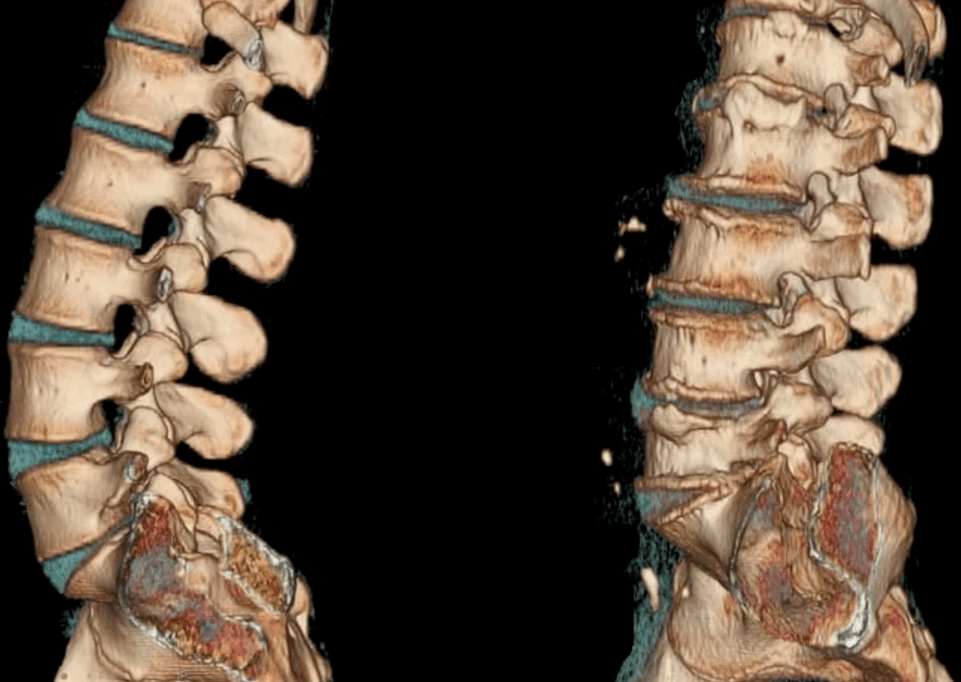Osteochondrosis is a chronic recurrent disease that occurs against the background of the constant destruction of vertebrae and intervertebral discs.Depending on the localization of vertebrates, they distinguish degenerative changes between the chest, lumbosacralis pathology and the neck.The leading symptoms of osteochondrosis are pain whose severity increases during the physical exertion and stiffness of movements.In the clinical picture there are often vertebral bodies: headache, blood pressure jump, a decrease in visual acuity and hearing.

The diagnosis is based on the results of instrumental research - radiography, MRI, ct.Medicines of various clinical and pharmacological groups are used in the therapy of osteochondose.In order to increase your clinical efficiency, physiotherapeutic and massage methods are carried out.One of the main methods for therapy and prevention is physiotherapy exercises.
The development mechanism of the disease
The pathogenesis of osteochondrosis is based on the loss of pulposus due to the core of its hydrophilic properties.This Semi -Blquid structure consists of connective tissue fibers and jacket.When a person grows up, the vascular channel is removed between the vertebrae in each pane.The absorption of nutrients occurs diffusely, ie according to the principle of spontaneous leveling concentrations.This explains the impossibility of completely restoring cartilage tissue after an injury or excessive physical exertion on the spine.
The processes of osteochondrosis aggravate changes in the hormonal background and an unbalanced diet.The amount of nutrients that are sufficient for their full functions does not enter the cartilage tissue, which causes the following diseases of their structure and properties:
- Strength and elasticity are lost;
- Form, consistency and configuration change.
Intermediate Wirebral discs are flattened and radial cracks are formed in fiber rings.This leads to a reduction in the distance between neighboring vertebrae.The connective tissue of fiber and ribbons are gradually involved in the pathological process.In response to the decay of tissues, the immune system begins to produce immunoglobulins, which leads to an aseptic inflammation and the formation of edema in the joint of the joints and the soft tissues nearby.The capsules of the joints are stretched so that the intervertebral discs reliably fix the vertebrae.And with the instability of segments between vertebral stands, the likelihood of a violation of the nerve root or pressing the blood vessel increases.This often occurs in cervical osteochondrosis and causes its pronounced symptoms.
Causes and provocative factors
In the state of the intervertebral discs, the reduced tone of the skeletal muscles of the spine has an adverse effect.Irrational, asymmetrical functions of the muscles occur at z.The destruction of cartilaginous fabrics can be provoked by constantly wearing a heavy bag on a shoulder, a dream on a soft mattress and a high pillow.
The following external and internal negative factors also accelerate the destruction of the intervertebral discs:
- Endocrine and metabolic disorders;
- Infectious pathologies, especially chronic;
- Previous spine injuries (compression fractures, bruising);
- Frequent hypothermia;
- The presence of systemic or degenerative dystrophic diseases, psoriasis, rheumatoid arthritis, arthrosis, osteoporosis.

If a person has bad habits, they are at risk.Smoking and abuse of alcohol worsen the condition of the blood vessels, lead to an inadequate bloodstream and the lack of nutrients in the cartilage fabrics of the windows.
In the presence of flat feet or club foot, the risk of osteochondrosis of localization increases significantly.Such congenital or acquired defects are the reason to increase the load of the spine, as they are impossible to ensure proper depreciation with the support.The factor that is predisposed to the development of the pathology is obesity.
With the deposition of fat tissue in different parts of the body, the support of the balance is complicated, which leads to the effects of excessive loads on the band fire connections.
Clinical picture
The first clinical manifestation of cervical, breast or lumbar balosteochondrosis is back pain.In the event of relapses, it is penetrated and radiates into the nearby part of the body.The slightest movement leads to an increase in pain syndrome.The reaction of a person is the introduction of a forced position in which the intensity is minimal:
- People with cervical osteochondrosis prefer not to turn their heads aside but the whole body.
- With a breast pathology, a person is even afraid to get a full air, as this becomes the cause of acute pain in the Brustr region.
- Patients with lumbar osteochondrosis are difficult to get up and go due to the violation of the spine nerve.
Most patients complain to the doctor about stupid pain and a feeling of restricting movements in the morning.This requires an additional differential diagnosis to rule out myositis (inflammatory process in the skeletal muscles of the back) and osteoarthritis.The reason for the occurrence of painful, oppressive pain is the compensatory stress of the muscle tissue in order to stabilize the affected vertebral engine segment.The constant pain syndrome of the weak or medium severity also occurs due to a significant section of the intervertebral disc and the development of aseptic inflammation.
Specific symptoms are characteristic of osteochondrosis of a certain localization.For example, lumboyshialgia often occurs in lumbar vertebral pathology - a pain attack in the lower back and in the back of the thigh.Thoraxic osteochondrosis manifests itself clinically through visceral pain in the heart region, in the right hypochondrium, in the stomach, in deafness, in increased skin sensitivity and in crunch in the vertebrae.However, the pronounced and most diverse symptoms differ in a pathology that influences the cervical intervertebral panes.
As a result of the shift of vertebrae, the formation of osteophytes, the vertebral artery is compressed, which feeds the cells of the brain, which delivers oxygen.One person suffers from the coordination of movements, noise in the ears, headaches, arterial hypertension.
What can be without treatment
Most of the complications of osteochondrosis occur due to the formation of the hernia of the intervertebral disc.It is formed when this vertebral structure is moved, which leads to a break of the rear longitudinal tape.The hard drive becomes even more unstable and part of it protrudes into the Cerebrospinal Canal.A hernia is considered exploding if in the process of their education together with the hard drive, its target core penetrates into the channel.
Such a pathological state of vertebrates predisposes for the compression of the spinal cord and the development of disogenous myelopathy.Clinically, it manifests itself in Torpor, the weaknesses of some muscle groups of the legs or arms, the parese, muscle atrophy, a change in tendon reflexes.The emptying of the bladder and the (or) intestine can also be observed.As a result of the formation of voices, arteries that feed the spinal cord are pressed.Ischemic areas are formed in which all nerve cells were killed.The so -called neurological deficit occurs - movements are violated, the sensitivity is reduced and trothy is annoyed.

Tactics of treatment
Osteochondrosis is not suitable for complete healing, since the drugs have not yet been synthesized, the recording of which would restore damaged intervertebral discs and vertebrae.However, the therapeutic systems necessarily include chondroprotectors - symptomatic active ingredients of a slow effect.Medicines with active chondroitin components with sulfate and (OR) glucosamine sulfate (hydrochloride) are given.
The clinical effectiveness of these medicines is confirmed by the results of a long -term research.With long recording (from 3 months to 2 years), a partial regeneration of cartilaginous tissues and other connective tissue structures occur - ligaments, tendons, bournes.Since they accumulate in the intervertebral discs of glucosamine and chondroitin, they start to have an anti -inflammatory effect in anti -inflammatory effect.In this way you can reduce the doses of NSAIDS, glucocorticosteroids and muscle relaxants and thus reduce the pharmacological stress on the body.
Medicines for joints are with irregular use or their use to treat osteochondrosis of the 3rd degree if a significant destruction of cartilage tissue is observed.
In order to remove symptoms that normally occur with cervical or chest osteochondrosis, medication is used to improve blood circulation and nootropics, a medication that improves the microcirculation of the labyrinth used for the pathology of the vestibular apparatus.
If necessary, antidepressants, anticonvulsants are included in therapeutic schemes.
In the treatment of osteochondrosis, physiotherapeutic methods are used: UHF therapy, magnetotherapy, laser therapy.Reflexotherapy, massage, training therapy, hirudotherapy, swimming, yoga are used.With the ineffectiveness of conservative treatment, the patient shows surgical intervention.The practices are practiced by the hard drive, its laser reconstruction or replacement of the implant.


































